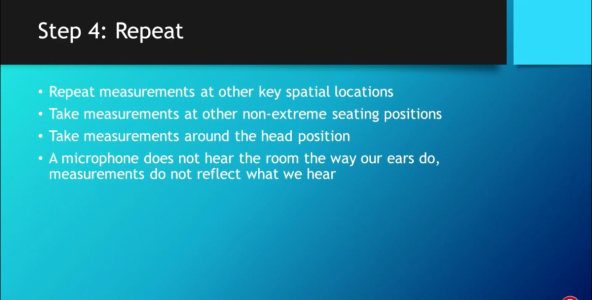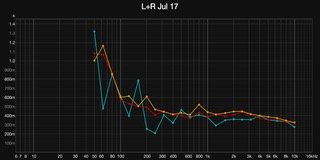You are using an out of date browser. It may not display this or other websites correctly.
You should upgrade or use an alternative browser.
You should upgrade or use an alternative browser.
RT60 measurement in my room
- Thread starter Analogous
- Start date
Don’t know.Reducing the RT60 in the low bass may make the overall system (speaker + room + listener) sound anemic ... ?
The AI part of the search results complied this:
For any passive object to interact with a specific wavelength, its size needs to be approximately one-quarter of the wavelength. This makes it challenging to treat low frequencies using any passive device to reduce RT60.
Example: The wavelength of an 80Hz sound wave in air is approximately 4.3 meters or 14.1 feet. The REW measurement indicates a problem between 60-100Hz in my room. This translates into large (ugly) corner bass traps.
But more worryingly I am not able to hear the reverberant bass or boominess. So pondering …
Last edited:
prateekatasniya
Well-Known Member
Tuned bass traps is the solution..
Or else multiple subs calibrated using DIRAC
Or else multiple subs calibrated using DIRAC
Thanks.Tuned bass traps is the solution..
Or else multiple subs calibrated using DIRAC
What’s a Tuned Bass trap?
square_wave
Well-Known Member
I am also curious about this.Thanks.
What’s a Tuned Bass trap?
I am guessing it refers to bass traps constructed with careful consideration to the density and thickness and dimensions to absorb just enough to tame the excess reverb in a particular room. If this is true, the next question is how is all this calculated?I am also curious about this.
square_wave
Well-Known Member
Gotcha. However, if the problem is between 40 and 100 hz, you will land up with bass traps that are quite large. Are there materials that will work on such large waves but are smaller in size ? I was wondering how one can make it small even if it is tuned.
I have seen people using DSP to fix such issues in bass in rooms where you cannot accommodate such large size traps. Especially Dirac.
I have seen people using DSP to fix such issues in bass in rooms where you cannot accommodate such large size traps. Especially Dirac.
I think the larger size of the wavelengths at these frequencies will dictate the density and thickness of the bass traps. If using bass traps they are going to be large and ugly.Gotcha. However, if the problem is between 40 and 100 hz, you will land up with bass traps that are quite large. Are there materials that will work on such large waves but are smaller in size ? I was wondering how one can make it small even if it is tuned.
I have seen people using DSP to fix such issues in bass in rooms where you cannot accommodate such large size traps. Especially Dirac.
I am reluctant to go the DSP-DIRAC route, but a equaliser that allows adjustments by hearing might be one way.
The big issue for me is I am not hearing the RT60 problem identified by the REW process.
I spent several hours today with a variety of music trying to do this.
Maybe I will just let it be and enjoy it as it is.
Sometimes what the mind does not know, the ear will not hear
grindstone
Active Member
Yeah, RT60 can mislead. Trust your ears. The utility of RT60 is that it's mostly repeatible. People (all of us) try to improve what we can measure, right?
IMO, the wavelets are the way to try to make sense of what something might be and whether it is (or should be?) fixable or not.
IMO, the wavelets are the way to try to make sense of what something might be and whether it is (or should be?) fixable or not.
Thanks for this useful and informative tutorial.Yeah, RT60 can mislead. Trust your ears. The utility of RT60 is that it's mostly repeatible. People (all of us) try to improve what we can measure, right?
IMO, the wavelets are the way to try to make sense of what something might be and whether it is (or should be?) fixable or not.
We did not perform the first three recommendations. I was not aware of the fourth in the list.

Well, if you don’t hear them, then it is better not to bother about it and enjoy the music the way it is.
I think a balanced subjective + objective approach would be beneficial. In other words, you would know which to consider and which to discard, based on your own personal preferences and judgment. It is all about perception.
One crucial information that is missing is that the speakers are Open Baffle. With these type, the room then acts as a cabinet.
A good internal damping is needed for the cabinets. The reason is that the sound waves from the rear of the woofer cone travel backwards and reflect back on to the same surface. If not damped properly they could interfere with the woofer movement, thereby making the sound muddy and smeared.
This is more pronounced with higher volume (SPL > 75dB). So, the stagnating waves and the nodes will further accentuate the issue.
I think a balanced subjective + objective approach would be beneficial. In other words, you would know which to consider and which to discard, based on your own personal preferences and judgment. It is all about perception.
One crucial information that is missing is that the speakers are Open Baffle. With these type, the room then acts as a cabinet.
A good internal damping is needed for the cabinets. The reason is that the sound waves from the rear of the woofer cone travel backwards and reflect back on to the same surface. If not damped properly they could interfere with the woofer movement, thereby making the sound muddy and smeared.
This is more pronounced with higher volume (SPL > 75dB). So, the stagnating waves and the nodes will further accentuate the issue.
Purchase the Audiolab 6000A Integrated Amplifier at a special offer price.
Similar threads
- Replies
- 8
- Views
- 2K
- Replies
- 1
- Views
- 5K
- Replies
- 3
- Views
- 2K


